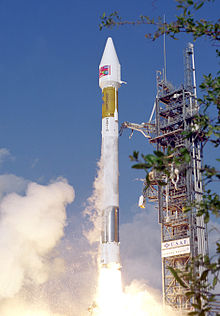
Back Атлас II Bulgarian Atlas II BJN Atlas II Czech Atlas II German Atlas II Spanish اتلس ۲ Persian Atlas II Finnish Atlas II Galician אטלס 2 HE Atlas II ID
 Launch of an Atlas II rocket | |
| Function | Medium-lift launch vehicle |
|---|---|
| Manufacturer | Lockheed Martin |
| Country of origin | United States |
| Size | |
| Height | 47.54 m (156.0 ft) |
| Diameter | 3.04 m (10.0 ft) |
| Mass | 204,300 kg (450,400 lb) |
| Stages | 2.5 (3.5 with IABS) |
| Capacity | |
| Payload to LEO | |
| Mass |
|
| Payload to GTO | |
| Mass |
|
| Associated rockets | |
| Family | Atlas |
| Launch history | |
| Status | Retired |
| Launch sites | Cape Canaveral, LC-36 Vandenberg, SLC-3 |
| Total launches | 63 (II: 10, IIA: 23, IIAS: 30) |
| Success(es) | 63 |
| First flight | II: December 7, 1991 IIA: June 10, 1992 IIAS: December 16, 1993 |
| Last flight | II: March 16, 1998 IIA: December 5, 2002 IIAS: August 31, 2004[2] |
| Type of passengers/cargo | SOHO (Atlas IIAS) TDRS (Atlas IIA) |
| First stage | |
| Powered by | 1 × RS-56-OSA |
| Maximum thrust | 386 kN (87,000 lbf) |
| Specific impulse | 316 s (3.10 km/s) |
| Burn time | 283 seconds |
| Propellant | RP-1 / LOX |
| Boosters – MA-5A | |
| No. boosters | 2 |
| Powered by | 1 × RS-56-OBA |
| Total thrust | 2,093.3 kN (470,600 lbf) |
| Specific impulse | 299 s (2.93 km/s) |
| Burn time | 172 seconds |
| Propellant | RP-1 / LOX |
| Boosters (Atlas IIAS only) – Castor 4A | |
| No. boosters | 4 |
| Maximum thrust | 433.7 kN (97,500 lbf) |
| Total thrust | 1,734.8 kN (390,000 lbf) |
| Specific impulse | 237.8 s (2.332 km/s) |
| Burn time | 56 seconds |
| Propellant | HTPB[3] |
| Second stage – Centaur II | |
| Powered by | 2 × RL-10A |
| Maximum thrust | 147 kN (33,000 lbf) |
| Specific impulse | 449 s (4.40 km/s) |
| Burn time | 392 seconds |
| Propellant | LH2 / LOX |
| Third stage (optional) – IABS | |
| Powered by | 2 × R-4D |
| Maximum thrust | 980 N (220 lbf) |
| Specific impulse | 312 s (3.06 km/s) |
| Burn time | 60 seconds |
| Propellant | N2O4 / MMH |
Atlas II was a member of the Atlas family of launch vehicles, which evolved from the successful Atlas missile program of the 1950s. The Atlas II was a direct evolution of the Atlas I, featuring longer first-stage tanks, higher-performing engines, and the option for strap-on solid rocket boosters. It was designed to launch payloads into low Earth orbit, geosynchronous transfer orbit or geosynchronous orbit. Sixty-three launches of the Atlas II, IIA and IIAS models were carried out between 1991 and 2004; all sixty-three launches were successes, making the Atlas II a highly reliable space launch system. The Atlas line was continued by the Atlas III, used between 2000 and 2005, and the Atlas V, which is still in use as of 2024[update].
- ^ a b Cite error: The named reference
astronautixAtlasIIwas invoked but never defined (see the help page). - ^ Tariq Malik "Final Atlas 2 Rocket Orbits Classified U.S. Satellite", Space News, August 31, 2004 (Accessed September 24, 2014)
- ^ Wade, Mark. "Castor 4A engine". astronautix.com. Archived from the original on December 28, 2016.